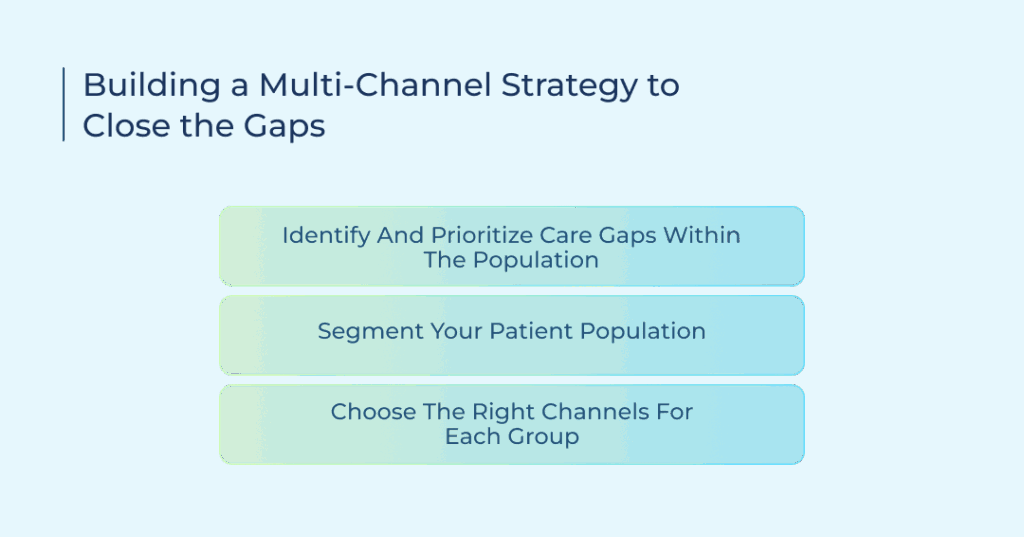Televox is proud to announce that its Enterprise Edition SMS solution has been awarded Gold…

Closing Immunization Gaps With Multi-Channel Outreach
When patients miss their vaccinations, it leaves both them and their communities exposed to preventable diseases that can lead to severe complications or even death. Multi-channel outreach provides a way for healthcare providers to close these care gaps.
It helps them improve the way they write and send vaccination reminders, while also applying methods for optimizing reach. We’re not just talking about tracking patients who are skipping their shots. Better outreach is the way to increase a community’s vaccination numbers.
What Are Immunization Gaps?
Simply put, every time someone misses a vaccine shot, they create an immunization gap for our healthcare system to close. These lapses are more common than most people think.
In 2024 alone, 14.3 million children around the world went completely unvaccinated. It gets worse because vaccinations are not just for babies. These gaps show up at every stage of life. Adults either skip the flu vaccine because they “feel fine” or don’t realize they should get a shingles shot once they’re past 50.
The timing matters as well because vaccinations work best during specific age brackets. If you missed your child’s measles shot at 12 months, thinking that you can always take them afterwards, your child will remain unprotected through the early school years, when the exposure risk is the highest.
What’s Causing Vaccination Gaps in Patient Care?
Immunization gaps are caused by several factors, but they all share common grounds that can be addressed with the right approach. Here are some of the biggest culprits:
- Logistics can sometimes be a driving factor. The nearest clinic might be too far away, or there might be other transportation challenges. Also, long waiting times and short clinic hours can be equally held responsible for limited access.
- Misinformation about vaccines and how they are not safe can lead a lot of people away. People tend to believe everything they see on social media without asking for proof. The same goes for hearing stories from friends and family.
- Next up is poor communication. Reminders are no good if they don’t reach the right phone or inbox. Add in complicated vaccine schedules, and patients often just aren’t sure what they need or when.
- Sometimes the problem isn’t with patients at all. EHRs may not transfer smoothly between providers, scheduling systems may not work right, or insurance questions drag things out until it’s easier to just skip the shot.
Limitations of Traditional Outreach Methods
Most healthcare providers still send out reminders the old way. They mail generic flyers about flu shots or leave voicemails that patients delete without listening. This approach misses huge chunks of the population who need vaccines most.
Ask yourself this: when did you last answer a call from an unknown number? 8 in 10 Americans say they don’t. Yet healthcare offices keep dialing away, wondering why their immunization gaps aren’t closing.
Mailed letters aren’t much better either, often ending up in the trash.
The real problem is assuming all patients communicate the same way. A single mom working two jobs can’t chat during business hours. An elderly patient might not check their email for weeks. Non-English speakers struggle with form letters written in medical jargon.
These one-channel strategies create blind spots. You’re essentially throwing darts at random, hoping your one message hits the right person at the right time through the right channel.
The Case for Multi-Channel Immunization Outreach
Smart healthcare organizations don’t put all their eggs in one communication basket. They text patients, call them, email reminders, and sometimes send letters. However, don’t take this as a way to spam people with messages. It’s about meeting patients where they actually pay attention.
The results speak for themselves. Carenet Health data shows a 70% member activation rate when calls are paired with text-based engagement solutions.
Multi-channel outreach works because it gives patients choices. Some people prefer getting vaccine reminders through text. Others want detailed information emailed to them.
Parents might like appointment confirmations via SMS, but need educational materials they can hold and read.
You can also time your messages better. Send a text reminder the day before an appointment, or follow up with a phone call if someone misses their appointment. Each channel serves a different purpose in helping close care gaps.
Most importantly, multi-channel strategies help close immunization gaps by removing excuses. Patients can’t say they never got the message when you’ve reached out through their phone, email, and mailbox. You’ve already covered all the bases.
Building a Multi-Channel Strategy to Close the Gaps
The way to close care gaps is by sending better messages instead of sending more. Different people need different approaches through different channels at different times. Once you accept that, you can start building outreach that actually works.

Identify and Prioritize Care Gaps Within the Population
EHRs already have the data to tell you who needs what and when. However, you still need to know how to use that data smartly. You can’t just start pulling random lists. Build your risk categories first, then match your outreach intensity to the actual need.
Zero-dose kids, for example, need your most intensive efforts. These families usually face multiple barriers, from language to transportation to trust issues. Your standard reminders will not work with them.
Segment Your Patient Population
Think beyond just age. Different age groups consume information differently. They also have different concerns.
The working single mom needs a different timing than the stay-at-home dad. The recent immigrant might need language-specific outreach and cultural sensitivity. The chronic disease patient has different motivations than someone getting routine preventive care.
Notably, communities with zero-dose children often have complex family dynamics where the decision-maker isn’t necessarily the person receiving your messages.
Choose the Right Channels for Each Group
Texting works great for young adults and busy parents who need quick reminders and scheduling links. Phone calls still matter for older adults who want to talk through their questions.
Postcards with QR codes offer a powerful middle ground. They combine the lasting visibility of mail with the convenience of digital scheduling, allowing patients to scan the code and book an appointment instantly. This approach is especially effective for people who may not regularly check email or text messages, providing another easy touchpoint that drives action.
Email is perfect for sending detailed information to people who actually read their inboxes. Even old-school mail reaches people who don’t have reliable phone service or internet access.
The sweet spot is usually two or three channels per person. You want multiple touchpoints without becoming annoying.
Use Automation for Scalability
You can’t manually call every patient who needs a vaccine. But you can use automation to handle routine reminders at a large scale.
Set up simple triggers, like follow-ups for no-shows or seasonal flu campaigns. This way, the system manages the easy tasks, while your staff focuses on the patients who truly need a conversation and support.
Optimize Message Timing and Frequency
The timing of your reminder matters as much as what it says. A best practice here is always to match your timing to your audience. A working parent won’t check their messages in the morning, but a retiree will.
Send one reminder before the due date, follow up if there’s no response, and add a final nudge after the due date. Test different timings for different groups to see what clicks.
Track Outcomes and Refine Based on Performance
Speaking of seeing what clicks, you need to have a system in place that tracks your reach and results. How many people read and responded to your message? How many were scheduled but never showed up?
Look for patterns. Which messages work best for which groups? What timing gets the best response? Which channels drive the most appointments? Use that data to get better.
Use Behavioral Nudges to Encourage Action
You can double your response rates by simply making small changes to how you word your reminders. People are used to hearing “Schedule your flu vaccine”. If they haven’t acted on that before, they won’t start doing so now. Instead, try making the reminder more personal. “Join the thousands of parents in our community protecting their families this flu season.” That sounds much better, creating urgency without panic.
Loss aversion is another behavioral approach, emphasizing what patients might miss. So, mention what might happen if they don’t vaccinate instead of listing vaccine benefits.
Test different behavioral approaches with your patient segments, since professional medical language may work for some populations while conversational, community-focused messaging resonates better with others.
Enable Self-Scheduling and Low-Friction Follow-Through
Here’s a proven formula: the easier you make it to schedule and receive vaccines, the higher your completion rates will be.
Your text reminders should include self-scheduling links. Your postcards should have QR codes. Offer same-day appointments when possible, and increase your clinic hours during flu season.
The goal is to make vaccination as convenient as possible while maintaining quality and safety standards.
How to Overcome the Challenges of Immunization Communication
The availability of enough vaccines or manpower is just a minor issue when put against communication barriers that actually prevent people from getting the shots they need to close immunization gaps.
- Language barriers present the greatest challenge. A patient will most likely disregard your vaccination reminder if it’s in a language other than their native one. Hence, communicating in patients’ native languages shows better results.
- Health literacy issues imply people are not able to comprehend vaccination details, even when it’s in their language. Medical jargon confuses patients, and complicated scheduling procedures overwhelm them. Simple, straightforward messages are more effective than long, convoluted medical explanations.
- Access issues also play their part. Living far away from the nearest clinic or being unable to get off work means interested people still miss their shots. Mobile clinics that travel into communities and workplace vaccination initiatives help close these care gaps.
- Hesitation to vaccines requires the most careful approach. People may have concerns about vaccines. It might even be some piece of misinformation they read online. Healthcare professionals need to hear and address their worries with genuine care.
Measuring the Impact of Multichannel Outreach for Improvements
Tracking specific metrics reveals which channels effectively close immunization gaps and which need adjustment. This also gives you concrete data to make informed decisions about your outreach investments.
- Contact rates – How many patients actually receive your message through each channel you use?
- Appointment scheduling rates – The percentage of contacted patients who book vaccination appointments after receiving outreach.
- Show rates – How many scheduled patients arrive for their immunization appointments?
- Care gaps resolution rates – The percentage of identified gaps that get closed within your campaign timeframe.
- Channel response rates – Which communication methods generate the best patient engagement for different groups?
- Opt-out rates – When patients request to stop receiving communications, signaling message fatigue or poor targeting.
How Can TeleVox Help With Effective Multi-Channel Outreach?
Every missed vaccination is a missed opportunity to protect your patients, their families, and the communities you serve. At Televox, we know the challenge isn’t that people don’t care about their health; it’s that you need better outreach to cut through the noise of daily life.
Our award-winning patient relationship management platform gives you the tools to deliver multi-channel outreach in ways that patients notice and respond to. Instead of one-size-fits-all flyers or endless voicemails, you can engage patients on the channels they actually use.
Televox also offers postcards with QR codes, combining the lasting visibility of physical mail with the convenience of instant digital action. Patients can scan the code to schedule an appointment immediately, making it easy to drive engagement and reduce missed vaccinations—even for those who don’t regularly use email or texting.
You decide the tone, timing, and content, and Televox helps make sure your messages are consistent, compliant, and scalable. Every communication is supported by HIPAA standards and consent management, so your outreach remains effective without adding risk.
And with Engage, your inbound virtual agent, patients can self-serve whenever it’s convenient for them. Whether they’re requesting prescription refills, handling billing questions, completing digital intake forms before appointments, etc, our conversational AI frees up your front-office staff to focus on care while giving patients the convenience they expect.
If you’re ready to see the difference for yourself, schedule a demo or connect with a Televox expert today.




